Read the series Introduction here.
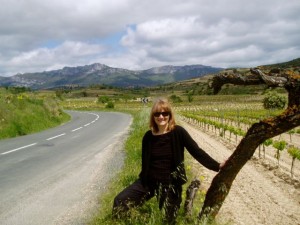
Elizabeth Yeoman near Nájera, Spain, on the Camino de Santiago (Photo credit: Maria Hernaez)
ELIZABETH YEOMAN is a professor at Memorial University of Newfoundland. Her teaching and scholarly publications are about language, culture, history and memory. Her poetry and travel writing have appeared in literary journals and she has contributed media pieces to the Globe and Mail, the Women’s Television Network and CBC Radio. She is currently working with Labrador Innu elder and environmental and cultural activist Elizabeth “Tshaukuesh” Penashue on a book based on Elizabeth’s diaries. Elizabeth Yeoman also blogs at Dinner in Strange Places.
* * *
These are my seven treasures:
1.
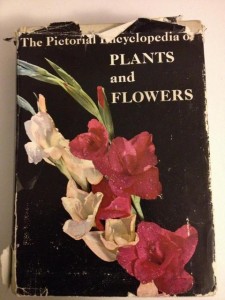 The Pictorial Encyclopedia of Plants and Flowers: I won this as a prize for an essay contest sponsored by the Nova Scotia Association of Garden Clubs when I was in Grade 7. I think the topic of my winning essay was the joy of gardening. My father took me to Halifax, a four-hour drive, to accept the prize at a banquet — but when we got there he said he was very tired and would I mind if we just went out for supper by ourselves. Though he was quite a prominent labour lawyer, he was reserved and self-effacing in his personal life, so perhaps after driving all that way he felt he couldn’t face a formal dinner among strangers. I didn’t mind; I too felt a bit reluctant now that we were so close to the actual event.
The Pictorial Encyclopedia of Plants and Flowers: I won this as a prize for an essay contest sponsored by the Nova Scotia Association of Garden Clubs when I was in Grade 7. I think the topic of my winning essay was the joy of gardening. My father took me to Halifax, a four-hour drive, to accept the prize at a banquet — but when we got there he said he was very tired and would I mind if we just went out for supper by ourselves. Though he was quite a prominent labour lawyer, he was reserved and self-effacing in his personal life, so perhaps after driving all that way he felt he couldn’t face a formal dinner among strangers. I didn’t mind; I too felt a bit reluctant now that we were so close to the actual event.
Instead we went to a Hungarian restaurant called Tokay, which I thought was the height of sophistication, treated ourselves to exotic food we had never tasted before, and drove home again: two shy escapees from public recognition and formality.
The book was mailed to me later and, as the photo shows, it has since been much enjoyed.
2.
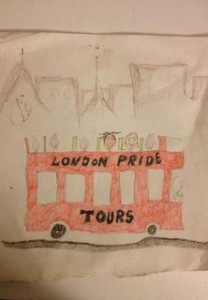 A drawing done by my daughter, Ilse, when she was 14: This is us on the top deck of a London tour bus; that’s her on the left and me on the right. She wasn’t very happy at that stage of her life but she liked London and she was dying to go on a tour. Though I didn’t want to, I agreed to go because she was so rarely excited about anything in those days.
A drawing done by my daughter, Ilse, when she was 14: This is us on the top deck of a London tour bus; that’s her on the left and me on the right. She wasn’t very happy at that stage of her life but she liked London and she was dying to go on a tour. Though I didn’t want to, I agreed to go because she was so rarely excited about anything in those days.
As soon as we climbed the stairs of the double-decker and emerged into the sunshine again to see the lions of Trafalgar Square and all of London spread out around us, her face lit up. We spent a memorable day together seeing the sights from our bus-top perch.
3.
My wedding ring: I have lost a total of four wedding rings. The one I wear now is the third, which I found again after losing the fourth.
I can’t remember how I lost the first one; it was so long ago and the details mundane. The second one was more dramatic. I was going to Spain with a friend, to walk the Camino de Santiago, and I said to David, my husband, that I wasn’t going to take any valuables with me, not even my wedding ring. “All right,” he said jokingly, “go ahead and look as though you’re single so you can pick up men.” I thought his joke might have just a touch of seriousness to it so I took the ring after all, but my hands swell when I hike and I ended up carrying it in a pouch with my passport. I have no idea how it got lost. I don’t think it was stolen; the passport was intact. The ring must have fallen out, and probably still lies somewhere on that ancient pilgrim trail.
My third wedding ring is a replica of an early-seventeenth century ring found at the Ferryland archeological site in Newfoundland. I lost it too, and felt so badly that I secretly tracked down the goldsmith and got him to make a copy: a replica of a replica! Later I found this one buried deep in a tiny forgotten pocket of a knapsack. For a while I wore both of them, but still later I managed to lose the copy.
One more and the “Five golden rings!” of the Christmas carol will hold true for me and we’ll move on to six swans a-swimming. “More difficult to lose them,” David mutters.
4.
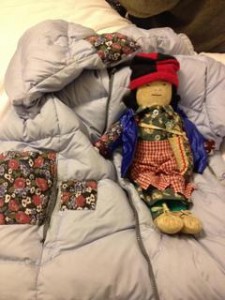 A patched jacket and a mini replica of it: I bought this jacket to take to Labrador for a week-long trip into the bush on snowshoes. It was 30 below and the jacket was essential, but the very first night in the tent I brushed against the red-hot wood stove and melted huge holes in it. The down flew up like a cloud and my friend Tshaukuesh burst into laughter, then saw my stricken face and clamped her hands over her mouth. She found some fabric and a sewing kit and I spent that evening and the next day sewing, sewing, sewing: tiny stitches to keep the down in. It worked, and I was able to complete the trip.
A patched jacket and a mini replica of it: I bought this jacket to take to Labrador for a week-long trip into the bush on snowshoes. It was 30 below and the jacket was essential, but the very first night in the tent I brushed against the red-hot wood stove and melted huge holes in it. The down flew up like a cloud and my friend Tshaukuesh burst into laughter, then saw my stricken face and clamped her hands over her mouth. She found some fabric and a sewing kit and I spent that evening and the next day sewing, sewing, sewing: tiny stitches to keep the down in. It worked, and I was able to complete the trip.
After I got home to St. John’s, a small package came in the mail. It contained a mini replica of my jacket, patches and all. My Innu doll has worn it proudly ever since. When I look at it, I can imagine Tshaukuesh laughing to herself as she stitched it for me.
5.
Another book, Nigella Lawson’s cookbook Feast: I never expected to like the British cooking diva and domestic goddess. She is too successful, rich and glamorous for someone like me who always sides with the underdog. But as I found out when I finally read one of her cookbooks, she is also funny, self-deprecating and down-to-earth, and she understands what really matters in life. And in death.
Feast has a chapter on food for funerals and I love Nigella for that. When my friend Rita’s father died, she said, “If there’s anything good about a death it’s the sense of community.” A stream of people brought food to her house and her family didn’t have to cook for a week.
My father died suddenly not long afterwards, and it was the same for us. I remember one dear friend walking up the driveway carrying a tureen of lobster chowder and two more arriving together with homemade date squares and loaves of bread. There were plates of sandwiches and cakes everywhere. I couldn’t eat, but knowing the food had all come from people who cared was enormously comforting. And as Nigella puts it, “Any food is a reminder that life goes on, that living is important. That isn’t brutal: it’s the greatest respect you can pay to the dead.”
6.
One red mitten: When I was 22 years old, I spent a few months walking and hitchhiking around northern Europe by myself. I got a very cheap flight from Halifax to Prestwick, in Scotland, explored the Highlands, and then gradually made my way to Wales to visit my friend Joanna. After a week or two in her warm and ebullient company, I left to travel onwards. I really didn’t want to leave but I was afraid of outstaying my welcome and also I think I wanted to test my courage by making this solitary trip. It was a record cold winter and I was under-dressed for it: freezing and lonely, with very little money, but determined to complete the itinerary I had planned.
Several weeks later I arrived in Amsterdam where the canals had frozen solid and everyone was skating, warmly clad, ruddy-cheeked and cheerful. Not having skates with me, I watched from a bridge, spent the night in a bleak military-style hostel, and the next day made my way to the post office to retrieve a small clutch of airmail envelopes with Canadian stamps and, best of all, a package and a letter from Wales. Joanna had noticed my inadequate winter garb and decided to knit me a pair of bright red mittens. But she had finished only the first one and, in her enthusiastic way, sent it along without its mate, promising to send that too as soon as it was done.
I never did get the second one. Still, I wore this single vivid mitten for the rest of that long cold winter and, even if it only kept one hand warm, it was wonderfully comforting.
7.
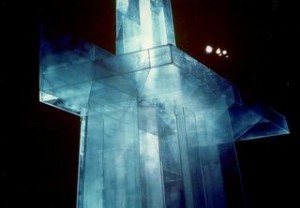 A photograph of a theatrical setting for Patrick Meyers’s play K2: My brother, Alan, built this abstract replica of the mountain K2 for a performance of the play at the Centaur Theatre in Montreal. He gave me the photo, in a frame he had also made himself, not long before he died of cancer in his early fifties.
A photograph of a theatrical setting for Patrick Meyers’s play K2: My brother, Alan, built this abstract replica of the mountain K2 for a performance of the play at the Centaur Theatre in Montreal. He gave me the photo, in a frame he had also made himself, not long before he died of cancer in his early fifties.
Alan had by then built a successful career as a stage carpenter after barely passing Grade 12 (the second time around) and then trying various trades and vocational programs. He had spent most of his high school years playing bridge and pinball, and several months after that carving a single highly detailed stone chess piece. I suppose when he realized how many more there were still to carve and how little the whole set would be worth in relation to the amount of work involved, he decided to cut his losses.
The career he eventually found suited him: creative and meticulous, solitary and independent, yet with the potential, when he wanted it, for the conviviality of the theatre. When he gave me the photo, he said with characteristic understatement and just a hint of pride, “I think when Dad came to the play and saw that, it was the first time he realized I wasn’t just a bum.”
Thoughts? Comments? What’s one of your seven treasures?
Elizabeth,
As each person on Allyson’s site tells about their seven treasures, I’m amazed with how monetary value has nothing to do with treasure (unless you’re a pirate). For all the special reasons you noted, those items are your touchstones. You’ve obviously had an interesting life, but all the accolades and compensation pale beside the emotional tug of what the items mean to you. I think especially of the red mitten. How many times have come across it and wondered if it was time to let go of the half of a whole. But you didn’t. It would have been like throwing away Joanna and all the effort for independence and uplift you get from accomplishment. And a mitten doesn’t take up much space.
I agree, Mary. And also I think there is some magical power in having half of something. One of my favourite books of childhood was E. Nesbit’s The Story of the Amulet, in which the protagonists have half of an amulet and that half enables them to travel through time to seek the other half – which will bring them even more wondrous things when they find it. And Joanna and I are still friends across the miles!
Elizabeth, I love you! I had completely forgotten the mitten… in fact I had completely forgotten I used to knit. This brings it all back: knitting ferociously to give my hands something to do to stop them reaching for a packet of cigarettes.. sitting through student ASH meeetings (the virulent anti-smoking association I joined to keep myself on the straight and narrow…) but most of all
seeing you, the epitome of worldliness for me, the great adventurer! I was, and am, so proud of your hikes, your walks and your kayaking even though it does make me feel like a slug in comparison.
I treasure your bottle of Amen liqueur brought all the way back in your rucksack from Compostelle knowing even from my modest hikes how heavy a rucksack gets with just the bare essentials.
From my first marriage I salvaged your pewter tastevin,the houses change but it remains a familiar face, a friend in every new kitchen drawer. Over the years it’s served as everything from mini-ashtray (during my many backslidings into tobacco) to loose-tea spoon but never once for wine!
From my teens I’ve kept (somewhere) the homemade card sent by you, my exotic friend from Canada who I’d boast about if given a chance (fortunately you didn’t know that as it would have made you cringe) The card had a funny man holding a beer bottle with ‘Sköl!’ written on it and I kept it on my mantlepiece for months – that heady mixture of handrawn sketch, umlaut and alcohol represented everything I wanted to be: artistic, daring and elsewhere….
Joanna!! Your comment is so evocative, it’s a fully fledged Seven Treasures in its own right. Just add photos. And you did turn out to be “artistic, daring and elsewhere” – I get to boast about you every time somebody admires one of your sculptures st our house, which happens often. In case anybody reading this would like to admire them too, they can be seen at http://www.artactif.com/hair/
Elizabeth, there is so much journeying embedded in your treasures. In 500 years or so, I bet some archaeologist in Spain will find your ring and make a replica of it!
Hello, Morgan. I just saw your comment now, several months after you posted it. I love the idea of an archeologist finding my ring and making a replica of it!